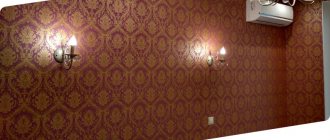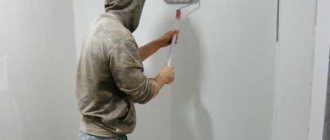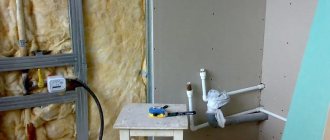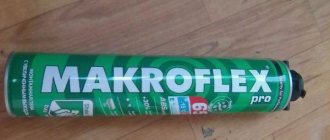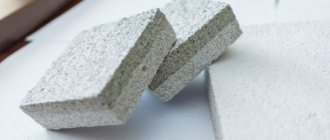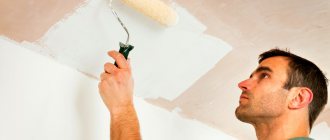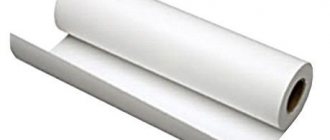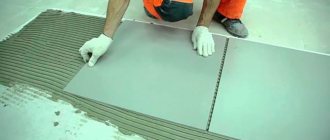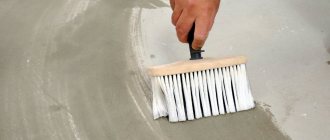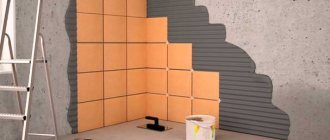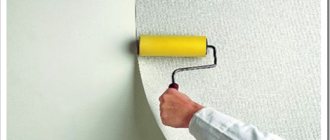The key to the success of every repair is its implementation in accordance with technologies and instructions. Today there is a huge number of different building materials on sale, a huge share of which is occupied by finishing mixtures. But the fact is that when it is applied to the surface after some time, sometimes observed after 1 year, the finishing begins to fall off in places. Sometimes even whole layers. And even if it was not very beautiful and of high quality, the foundation for it was not properly prepared. This is where the primer comes to the fore. And the resulting tandem of “primer and putty” should not easily bounce off the teeth of any master in exactly this sequence of words, he should live by this phrase.
Penetration level of primers into concrete
Even the ancient Greeks knew the technology of surface priming and its main role. After all, it is thanks to such mixtures that the loose and free-flowing base becomes durable. Primer in painting was especially popular in ancient times; it was first applied to the canvas or wall, thanks to which today we can observe long-standing works of art.
What comes first, primer or putty?
If you decide to do renovations, then you should not waste your money on finishing materials and a special role should be given to preparatory operations. For example, you plan to plaster a wall followed by decorative finishing.
Before putting putty, primer, or wallpaper, it is necessary to prepare the base. We remove the old coating and remove crumbling components as much as possible. Then we take the plaster mixture and get down to business. But what!! Everything falls off either immediately or after a while. And then we realize that we missed an important thing. Primer. Therefore, answering the question “What comes first, primer or putty, plaster, etc.?” we can confidently say, of course, a primer. And why?
Soil action
The primer includes components that, when deeply soaked into the base, fasten and glue it together, resulting in a rough and fairly durable surface. But you shouldn’t rush here either, because if you don’t let the primer dry, all the work will go down the drain.
In the case of concrete and brick walls, many may doubt the need for a primer for putty, but, of course, this is a wrong opinion. But in the case of wooden coverings, the question “Are the walls primed or puttied first?” doesn't make any sense. Because here it will be clear that nothing will stick to a smooth wooden surface without the use of any treatments.
Main tasks
It is not difficult to determine whether it is necessary to prime the walls before laying tiles, because these mixtures significantly improve the quality of adhesion of various materials to the surface. Even tiles in this case are no exception. Thanks to the primer, the base itself becomes stronger, which will allow the wall to withstand the load much more easily.
Even if some parts of the base do not adhere to each other very well, then this circumstance can be changed with the help of a primer. Do not forget about the protective capabilities of soil mixtures. As a result of their use, the walls will be reliably protected from the occurrence of fungi, mold and other pathogenic bacteria. You can achieve the best result only if you choose the right primer for a specific finishing material.
It is easy to understand whether the walls need to be primed before plastering or applying other finishing materials. Soil mixtures have a lot of positive properties, which is why experts do not advise saving on this action.
If you find an error, please select a piece of text and press Ctrl+Enter.
Primer properties
The properties of primer mixtures include:
- Increasing the adhesion of subsequent finishing layers (plaster, paint, putty, drywall).
- The primer is an excellent antiseptic that can prevent and destroy fungal growth and mold even in the thickness of the wall.
- The primer ensures high quality and durability of the repair.
Subtleties of application
It is best to apply the primer in two layers: the first is placed between the wall under the plaster and putty, and the second after putty. Then the applied materials will not be able to peel off or crumble. The primer forms a protective layer, allowing the two layers inside to firmly connect (adhere).
Everyone has the right to choose the soil that they consider most suitable for the walls in their home. The variety of assortment allows you to replace them one with another, it is only necessary to take into account the degree of humidity and air temperature in the room. A universal material that can treat any surface is an acrylic mixture. Before applying to the wall, the composition is diluted with water.
How to prepare walls for painting // Nathan Group
The mixture of medium penetration is applied to surfaces under wallpaper or before painting walls. Wallpaper should not be heavy.
For others, deep penetration mixtures are used. In this case, the wallpaper will last for a long period of time.
The process does not require any special skills or abilities.
The mixed primer is poured into the container. If the mixture is dry, then it is diluted with water. If the solution is concentrated, then it is prepared taking into account the proportions indicated on the package.
Next, the walls are coated with a brush evenly and thoroughly, especially in places where there were cracks or damage. When the walls are old, then in order to strengthen them efficiently and reliably it is necessary to apply the mixture in a thicker layer. If the base is porous, then the soil is applied until the hollows are completely filled. The solution is applied with a roller from bottom to top. Distribute the solution over the entire area of the base.
Drywall can also be processed in a similar manner. The entire surface is evenly treated with the prepared (diluted with water) mixture. Use a brush to clean the joints and areas for screws. The subsequent drying time of the solution depends on its type.
After the primer has dried, a thin layer of finishing putty is applied to any surface. This is how the walls are leveled. Reinforced tape is glued to the drywall at the joints. After drying, it is necessary to apply the final primer again.
Types of Primers
Types of primers and prices
Having established that primer is an important component of any repair, the next question should be: “Which primer is best for putty walls?” It is impossible to answer unequivocally here, because there are at least 7 varieties of them on sale. And in order to choose the one you need, you should familiarize yourself with its composition, action and what materials it interacts with. Because each primer for walls before or after putty interacts with the base differently.
Types of primers
- One of the most common is acrylic primer. It is an excellent tool for treating loose surfaces. The advantage of this primer is that it dries quickly (up to 5 hours), is easy to apply with a roller or brush, and at the same time adheres well to surfaces made of concrete and wood, plasterboard, or gas silicate blocks. But it interacts poorly with metal, which affects its further corrosion. It has excellent adhesive properties, giving the loose and porous surface the necessary strength and stability . Priming walls for putty with this material will ensure the durability of your finishing repairs, and your pocket will be full of money. Acrylic primer is suitable for use both outside and inside a residential building.
- The next equally popular type of primer is alkyd. It is used primarily for wood flooring. Provides a durable contact layer that is rough to the touch, on which putty, plaster, or gypsum can be subsequently applied. It can also be used for both external and internal work in a residential building. Drying and complete hardening of this material occurs at room temperature for 15 hours.
- Glyphthalic primer is often used for finishing work. It is advisable to use it exclusively for dry rooms. The full hardening cycle is 24 hours at room temperature. The advantages of this primer include the ability to treat metal surfaces.
- The next type of primer, classified as synthetic, is polyvinyl acetate. It has an exclusively special purpose for painting with polyvinyl acetate-containing paints. Recommended for use for outdoor work. The polymerization process takes only 30 minutes.
- The next, no less toxic, but more effective is perchlorovinyl primer. It is prohibited to use it indoors due to the high concentration of chemically active substances. But for outdoor work this is one of the best options, despite the fact that it dries in just 1 hour. And it can also be used on a metal base.
- The next type of highly toxic primer is polystyrene. It adheres well to any materials, which makes it an excellent option for outdoor use.
- The next type is phenolic. It adheres well to wooden and metal surfaces, which is why it is not recommended for use indoors. The complete hardening cycle is 15 hours.
The meaning of priming
Man began priming surfaces at the beginning of his historical journey. Artists were the first to do this - without a special primer it is impossible to put paint on canvas. The primed surface not only held the paint firmly, but also allowed the master to work comfortably - the base of the painting became dense and uniform in roughness. The same functions are inherent in modern primers. Padding:
- saturates the wall surface with moisture before applying plaster, which prevents it from taking water from the solution;
- creates a film with deep penetration into the wall (up to 1 cm), which significantly improves adhesion between its surface and the plaster;
- removes dust, including in places inaccessible to a brush or vacuum cleaner;
- muffles color spots on the wall (but not a transparent primer), turning its surface into a more monochromatic one, which is very important when wallpapering concrete;
- creates a smooth, easy-to-finish surface.
Why prime the walls after puttingty?
If the primer before the finishing layer was simply necessary, then after finishing it is applied at the discretion of the master. Therefore, the question “Do I need to prime the walls after finishing putty?” quite relevant.
The primer will have the same effect under and above the finishing layer. The finishing layer of putty is a fairly dense material that is practically not susceptible to crumbling. And then at this stage the further finishing of the wall should be taken into account.
If you are going to be wallpapering, you can prime the surface with the wallpaper glue itself, after letting it dry. There is savings on primer, but more glue is required. The second case when it is possible not to use a primer is the subsequent painting of the wall with water-based compositions. The paint itself contains similar components to acrylic primer.
But priming the walls after puttying is mandatory, even after finishing, if liquid wallpaper, plaster decorative finishes, etc. will be glued to it.
Having understood the types and purpose of primers, you can now create a complete combination of high-quality and durable repairs: primer, putty, wall primer and decorative finishing.
Main functions of primers
The purpose of the primer is determined by its composition, the inclusion of an additional component in which will enhance the properties of the material in a certain direction. But most types of primer compositions, in addition to individual features, are united by common functions:
- strengthening the surface layer of the base;
- reduction of porosity with equalization of absorbent properties over the entire area.
To justify priming walls before painting or wallpapering, it is enough to consider how in demand the listed functions are when performing these types of finishing work.
Possible errors
If you leave a specific wall without a primer, then the likelihood that defective areas of the surface will appear will automatically increase. It is absolutely wrong to refuse this type of work in order to save money. This is absolutely not cost-effective, because the service life of even the most expensive coatings will be quite short. Very quickly the walls will again need expensive repairs. Using a primer pays for itself in the long run.
Do I need to prime the walls before wallpapering? Definitely yes! In this case, soil mixtures are also capable of performing a very important fixing function, and also significantly save the consumption of wallpaper glue. To achieve your goals, you need to choose the right mixture. Experts prohibit the use of polymer dispersions and water-based paints as primers.
Surface preparation
Some surfaces absorb moisture and others do not, so the primer material for them will differ significantly.
To prepare walls or ceilings for further processing (painting, wallpapering, etc.), you must do the following:
- clean the surface from dust and dirt;
- scrape off old paint if there is any;
- remove old wallpaper;
- wash and dry the walls;
- Fill cavities, cracks or chips with putty.
You can clean the surface from dust with a cloth or a vacuum cleaner. The paint and varnish material is removed using a spatula or paint scraper.
Wallpaper is removed with a metal spatula and hot water, which should be used to wet it. After this, the old layer swells. Removing wallpaper will now not be difficult.
After removing the previous materials, you need to wash the walls. If there are surfaces on which mold or mildew is concentrated, it is recommended to treat them with an antiseptic solution.
When the walls are washed, they are dried. An important point is that the drying process itself may take several days. It all depends on the surface on which the water was exposed.
When the installation of plasterboard surfaces is completed, they are prepared for priming. The soil acts as an insulating material, increases the adhesive properties of the surface, penetrates deeply into the material, thereby subjecting it to polymerization (strengthening it). The surfaces can be screwed to the wall frame or fixed to the ceiling. The primer should be selected taking into account the surface area on which it will be applied. Preparatory measures should be taken to process the structures in a high-quality manner so that later the finishing material (be it paint or wallpaper) will evenly adhere to the main surface.
To work, you will need a container for the mixture itself, rubber gloves, a brush, and a roller. It is possible to use a spray gun.
Tips and tricks
To improve the primer layer and the entire finish, it is recommended to follow the advice of experts. Among them are the following recommendations:
- It is not recommended to mix several primers of different types, as well as from different manufacturers. This should not be done if the primers are intended for one material. The fact is that the chemical composition of different primers may differ and when they are combined, the ingredients may simply not interact with each other. As a result, the quality of the coating will suffer greatly;
- The product must not be stored in diluted form. It must be used immediately after preparation. It is also strictly forbidden to keep even dry material in the cold. The fact is that such a storage temperature greatly affects the functionality and properties of the primer;
- Before using raw materials, you should always read the instructions on the packaging, as well as the recommendations for use and dilution from the manufacturer;
- To check the strength of the primer film, it is recommended to press it with a sharp metal object. The pressure should not be too strong. As a result, a small hole may form. But if cracks and tears appear from it, then the coating turned out to be of poor quality.
The primer on the putty performs many functions that can significantly improve the quality of the finish. In fact, this product is used several times in finishing. It must be applied not only after puttying, but also before it.
Sources:
https://iv-proect.ru/steny/nuzhno-li-gruntovat-steny-posle-finishnoj-shpaklevki.html https://vsyakraska.ru/shpatlevka/nuzhno-li-gruntovat-pered-pokraskoy/
